Daito-ryu Aiki Budo 118 Techniques (大東流合気武道百十八ヶ条)
by Yoshihisa Ishibashi (石橋義久)
Yoshihisa Ishibashi (石橋義久) was born in Tokyo in 1938 and started training in Daito Ryu at the Daitokan dojo in 1964, learning Aiki Budo and Ono Ha Itto Ryu Kenjutsu directly from Sokaku Takeda’s son Tokimune Takeda. In 1969, together with Yoshimi Tomabechi (苫米地芳見) and Katsuyuki Kondo (近藤勝之), he opened the Katsushika Branch Dojo in Tokyo and was its first head instructor. He received an Ono Ha Itto Ryu license from Junzo Sasamori (笹森順造) and has a breadth of experience from zen to judo, kendo, Shorinji Kempo, and Chen Tai Chi.
The “118 techniques” in Daito-ryu cover the techniques contained in the Hiden Mokuroku (秘伝目録) certificate , from Ikajo to Gokajo, and were taught as the core curriculum of Tokimune Takeda’s Daito-ryu Aiki Budo. The book “Daito-ryu Aiki Budo 118 Techniques” (大東流合気武道百十八ヶ条) was written by Yoshihisa Ishibashi and published in Japanese in 2015 by BAB Japan publishing company (BABジャパン出版局), which also publishes the popular martial arts magazine Gekkan Hiden (月刊秘伝 / “Secret Teachings Monthly”).
This is the English translation of a section from Ishibashi Sensei’s book that deals with solo training exercises for the development of breath power (“Kokyu-ryoku”) and Ki development.
You may also be interested in “Sagawa Yukiyoshi, Masaru Takahashi and Breath Training in Daito-ryu” for a look at breath training in the tradition of Yukiyoshi Sagawa.
Tokimune Takeda’s Daitokan (大東館) Dojo in Hokkaido, Japan
「陰陽合気法」は呼吸法によって臍下丹田に気を充実させ、気力集中をはかって精神統一をするというもので、五指を握り、静かに入息するを「陰」、五指を強く開き、出息するを「陽」と呼ぶ、とあり、この呼吸法を続けることによって、頭脳明晰となり、眼力は鋭く、「心」「気」「力」一致し、大勇猛心を養い、特に両手十指それぞれの活用により、神通力を高める。
“In-yo Aiki-ho” fills the Seika Tanden with Ki through Kokyu-ho and strives to concentrate Ki-ryoku through mental concentration. Closing the five-fingers, inhaling quietly is called “In” (“Yin”), opening the five fingers strongly and exhaling is called “Yo” (“Yang”). Through the continuation of this breathing method the mind becomes clear, the vision becomes sharp, the “spirit”, “ki” and “power” are unified, a courageous spirit is developed, and especially – the various practical applications of the ten fingers of both hands gives rise to superhuman powers.
– Tokimune Takeda – son of Sokaku Takeda, and Soke of Daito-ryu Aiki Budo
Solo Training for Kokyu-ryoku and Ki in Daito-ryu Aiki Budo
Kokyu-ryoku (呼吸力)
Training in Kokyu-ryoku (“breath power” / 呼吸力) is a method of practice that is required for the mastery of superhuman power and martial technique.
As I have mentioned previously, Aiki-age is an important training method for Kokyu and Ki. It is through training while focusing one’s awareness on the tanden (丹田) and Kokyu that one becomes capable of developing a power that is not muscular force.
Now I will introduce methods of training Kokyu and Ki other than Aiki-age.
Breathing Methods and Tanden (呼吸法と丹田)
(1) Abdominal Breathing and Reverse Abdominal Breathing
(腹式呼吸と逆腹式呼吸)
Abdominal breathing (normal abdominal breathing) is a breathing method in which one expands the abdomen when breathing in and contracts the abdomen when breathing out.
Reverse abdominal breathing is a breathing method in which one expands the abdomen when breathing out and and contracts the abdomen when breathing in.
The first priority for one training is to build a body that constantly employs abdominal breathing unconsciously and naturally. The mastery of abdominal breathing is an absolute requirement for entering the martial world and the world of Ki.
Without mastery of normal abdominal breathing, even if one learns various technical methods one cannot expect them to be very effective.
Awareness of the Lower Tanden (下丹田の意識)
Through reversing the order of the abdominal breathing method one awakens the lower tanden and becomes capable of breathing deeply.
The tanden is the source of energy. “Ta” (田) is the place where one raises food, but it is not something that exists naturally. It becomes a fertile field through human cultivation. Tanden is the same as that character, it is something that is built through self-cultivation.
Therefore, from times past it has been said that abdominal breathing is “the origin of health” (健康の素). I recommend that you master it quickly.
(2) It can be done anytime
Breathing methods (“kokyu-ho” / 呼吸法) can be practiced anytime that one realizes that they are in the appropriate environment, without choosing a particular time or place. For example, when one is riding the train by themselves, or in your bed, before you fall asleep. When one’s lower abdomen always moves up and down when one breathes naturally and unconsciously then one can be said to have mastered this breathing.
A – Abdominal Breathing (Normal)
- Inhaling slowly, expand the lower abdomen (the area from the navel down). At the same time, draw your anus upwards.
- Keeping your anus loose, draw in the area from your stomach to your lower abdomen while breathing out slowly.
Repeat the above without straining.
B – Abdominal Breathing (Reverse)
- This method of breathing is the complete opposite of normal abdominal breathing. Draw in the area from your stomach to your lower abdomen while keeping your anus loose and inhaling slowly.
- Expand the lower abdomen (the area from the navel down) while breathing out slowly. At the same time, draw your anus upwards.
Through the activity of Ki, and the power of Kokyu and vocalization, superhuman techniques become possible – these steps are required in order to realize this.
Tokimune Sensei’s Breathing Method
I will introduce the reverse abdominal breathing method of training contained in Tokimune Sensei’s personal notes.
Tokimune Takeda’s Reverse Abdominal Breathing Kokyu-ho Method 1
Kokyu-ho 1 (from Tokimune Sensei’s personal notes)
- Stand in shizentai (“natural stance” / 自然体), close both hands around their thumbs and place them on your hips.
- Drop your hips while performing reverse abdominal breathing (draw in your abdomen while inhaling, draw your anus upwards) . At the same time squeeze your fists strongly and grip the surface of the ground with your five toes.
- Expand your abdomen while exhaling, return your hips to their former position. At the same time, loosen your fists and loosen your five toes. Repeat the above 300 times.
Tokimune Takeda’s Reverse Abdominal Breathing Kokyu-ho Method 2
Kokyu-ho 2 (from Tokimune Sensei’s personal notes)
- Stand in shizentai and drop your hips slightly. Close both hands around their thumbs. Squeeze both fists and drop both underarms naturally.
- While exhaling raise your right fist (palm inwards towards you) up and to the right. (perform this as if assuming that a straight punch is coming from an opponent directly in front of you)
- Continuing, raise your left fist (palm inwards towards you) up and to the left while exhaling. At the same time drop your right fist down and to the right.
- Continuing, raise and lower your left and right fists in alternation. During that time breath strongly “Ha!” “Ha!” (reverse abdominal breathing) while lightly raising and lowering your hips. Repeat the above 300 times.
Ki Training (気の鍛錬)
(1) Concentration and Relaxation
Ki begins to take root throughout one’s body, begins to move, through relaxation of the mind and the softening of the entire body.
Ki is concentrated in parts of the conscious body. In our Ryu, we concentrate Ki in the necessary places of our bodies at the necessary time and apply techniques, or defend, parry, deflect or otherwise remove the power of the opponent.
When this can be done, Ki becomes a sharpened sensor in battle, and the opponent’s body can be felled through the use of one’s entire body as a weapon.
Aiki-age and Kokyu-ho, which I have discussed previously, are also effective as training methods for Ki, but here I will introduce a separate method for solo training in Ki.
(2) Use of the Fingers in Ki Training
Increased awareness of the fingers (the little finger and the thumb) is important in jujutsu and sword techniques. Either of these exercises can be done easily anywhere at any time. By all means, please try them.
Tokimune Takeda’s Ki Training Method 1
A – Thumb and Little Finger Ki Training 1
- Stand in shizentai and loosen your elbows. Hold both hands out in front of your chest with the palms up.
- Close both fists inward tightly, from the index fingers to the pinkies. Place your thumb horizontally above the index and middle fingers and grip particularly strongly with the thumb and little finger.
- Remove the tension from your shoulders and elbows and pull your arms lightly while inhaling. While concentrating your awareness on the tips of your fingers grasp both fists tightly and then loosen them.
- Repeat this exercise rhythmically about 300 times.
Tokimune Takeda’s Ki Training Method 2
B – Thumb and Little Finger Ki Training 2
- As in steps 1 and 2 above hold both of your hands out in front of your chest, but with the palms down.
- Remove the tension from your shoulders and elbows and grasp both fists tightly. While exhaling strongly thrust your thumb out to the front.
- Repeat this exercise rhythmically about 300 times.
(3) Ki Training with the Teppo (“wooden pole”)
Teppo Training, the wooden pole in Sumo
Here I will introduce a Ki training method employing the teppo movements used in sumo training. The following two methods differ in their breathing and the forces used when thrusting the hands forward.
When one turns their awareness to the focus of their Ki and stretching and loosening they can learn of the relationship between the movement and the breath.
Teppo Ki Training Method
A – Teppo 1
- Posture: Stand with your feet shoulder width apart and turn your toenails towards the front. Slightly loosen your knees, pull in your chin and stand up straight. Open the five fingers of both hands and pull both elbows into your ribs. Make an asagao (“morning glory” / 朝顔) with your hands and fix your gaze to the front center. While inhaling slowly expand your lower abdomen and drop your awareness to the lower tanden (continue to observe closely).
- While exhaling “Ha—” as slowly as possible, step forward with your right foot and move your upper body at the same time, slowly thrusting your right hand up and towards the center line (concentrate your awareness in the tips of your fingers).
- Return your right hand and right foot to their former positions while inhaling slowly, expanding your lower abdomen and dropping your awareness to the lower tanden (continue to observe closely).
Repeat the above on both right and left sides for about 15 minutes.
B – Teppo 2
- Posture: Stand with your feet shoulder width apart and turn your toenails towards the front. Slightly loosen your knees, pull in your chin and stand up straight. Open the five fingers of both hands and pull both elbows into your ribs. Make an asagao (“morning glory” / 朝顔) with your hands. Inhale slowly while maintaining an awareness of your tanden.
- While exhaling strongly in one burst “Ha!” – thrust your right hand strongly forward and up towards the center line while stepping forward with your right foot. Pull your right foot back while inhaling.
- While exhaling strongly in one burst “Ha!” – thrust your left hand strongly forward and up towards the center line while stepping forward with your left foot. Pull your left foot back while inhaling.
Repeat the above on both right and left sides for about 15 minutes.
Published by: Christopher Li – Honolulu, HI

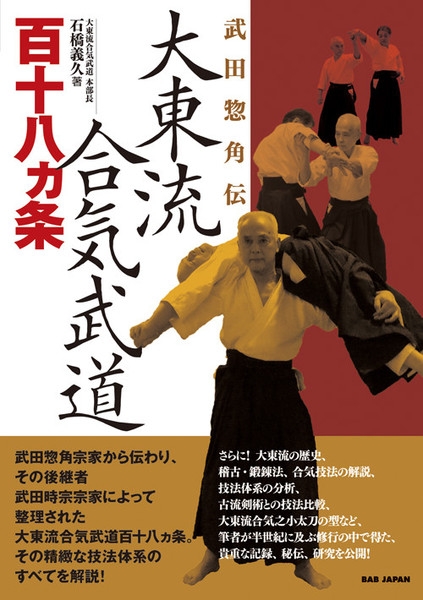
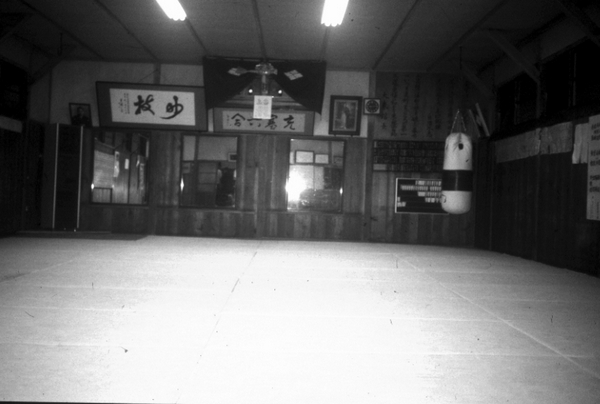
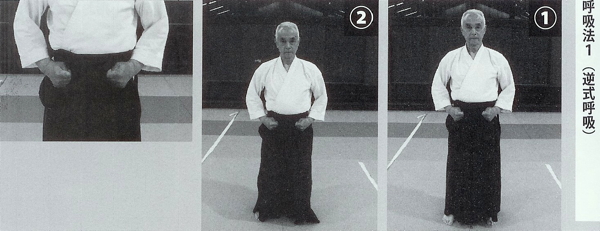
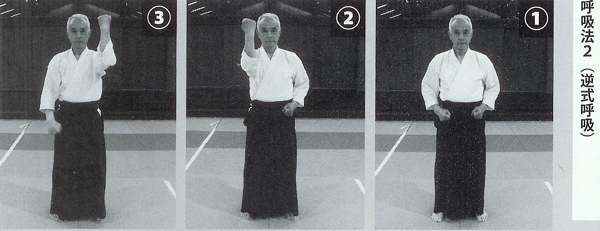
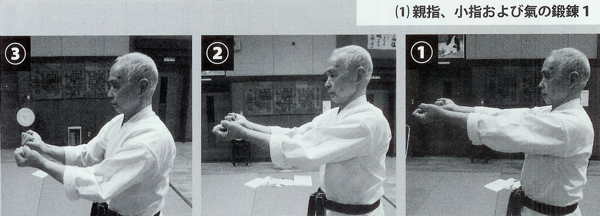

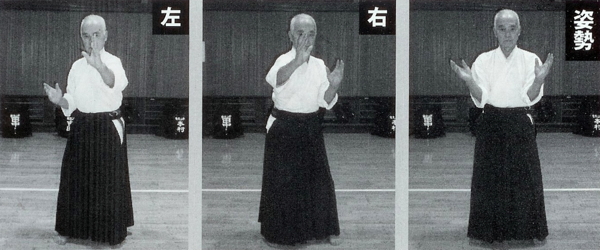


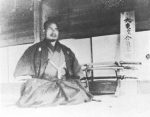
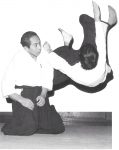


Leave a Reply